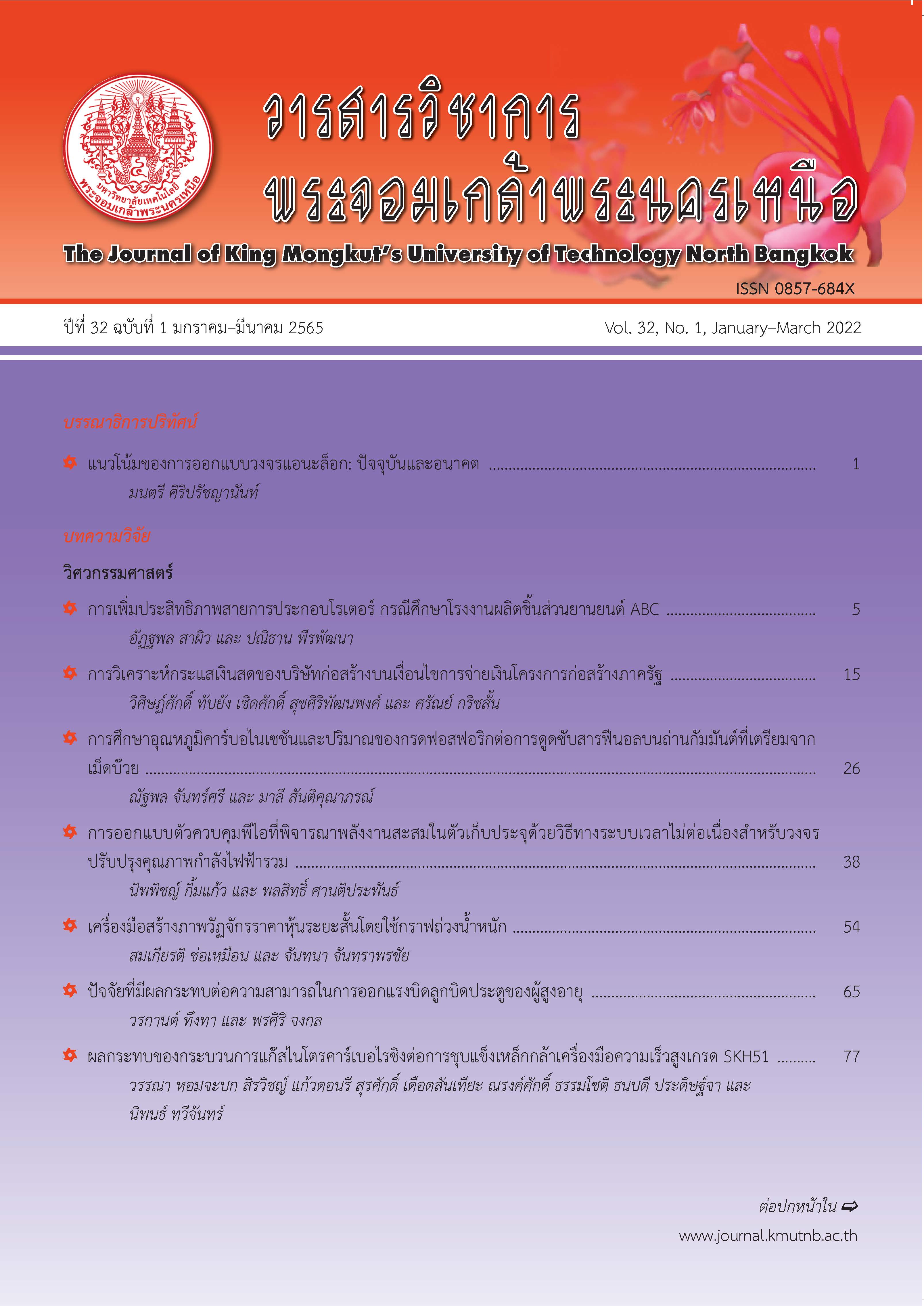การออกแบบตัวควบคุมพีไอที่่พิจารณาพลังงานสะสมในตัวเก็บประจุด้วยวิธีทางระบบเวลาไม่ต่อเนื่่องสำหรับวงจรปรับปรุงคุณภาพกำลังไฟฟ้ารวม
Main Article Content
บทคัดย่อ
การออกแบบพารามิเตอร์ของตัวควบคุมที่ไม่เหมาะสมกับระบบควบคุมดิจิตอลส่งผลกระทบต่อสมรรถนะการชดเชยของวงจรปรับปรุงคุณภาพกำลังไฟฟ้ารวม (วงจร UPQC) จากผลกระทบดังกล่าว บทความนี้นำเสนอกลยุทธ์ควบคุมร่วมกับการระบุเอกลักษณ์ฮาร์มอนิกด้วยวิธีควบคุมมุมกำลัง โดยมุ่งเน้นการออกแบบพารามิเตอร์ตัวควบคุมพีไอบนระบบเวลาไม่ต่อเนื่องสำหรับระบบควบคุมแรงดันบัสไฟตรง นอกจากนี้ บทความนี้ได้อธิบายหลักการทำงานของวงจร UPQC หลักการของวิธีควบคุมมุมกำลัง การไหลกำลังไฟฟ้าของวงจร UPQC และขั้นตอนการออกแบบพารามิเตอร์ตัวควบคุมพีไออย่างละเอียด ผลการจำลองสถานการณ์ด้วยโปรแกรม MATLAB/Simulink ยืนยันได้ว่า ตัวควบคุมพีไอที่ได้รับการออกแบบให้สมรรถนะการควบคุมแรงดันบัสไฟตรงที่ดี นอกจากนี้ วงจร UPQC สามารถฉีดแรงดันชดเชยและกระแสชดเชยให้กับระบบสามเฟสสามสายได้อย่างต่อเนื่อง ถึงแม้ว่าแหล่งจ่ายแรงดันและโหลดมีการเปลี่ยนแปลง
Unsuitable controller par
Article Details
บทความที่ลงตีพิมพ์เป็นข้อคิดเห็นของผู้เขียนเท่านั้น
ผู้เขียนจะต้องเป็นผู้รับผิดชอบต่อผลทางกฎหมายใดๆ ที่อาจเกิดขึ้นจากบทความนั้น
เอกสารอ้างอิง
[2] M. Kesler and E. Ozdemir, “Synchronousreference-frame-based control method for UPQC under unbalanced and distorted load conditioners,” IEEE Transactions on Industrial Electronics, vol. 58, no. 9, pp. 3967–3975, 2011.
[3] M. Aredes, K. Heumann, and E. H. Watanabe, “An universal active power line conditioner,” IEEE Transactions on Power Delivery, vol. 13, no. 2, pp. 545–551, 1988.
[4] V. Khadkikar and A. Chandra, “A new control philosophy for a unified power quality conditioner (UPQC) to coordinate load reactive power demand between shunt and series inverter,” IEEE Transactions on Power Delivery, vol. 23, no. 4, pp. 2522–2534, 2008.
[5] R. J. Millnitz, J. Carlo, and M. Mezaroba, “A simplified control technique for a dual unified power quality conditioner,” IEEE Transaction on Industrial Electronic, vol. 61, no. 11, pp. 5851–5860, 2014.
[6] Z. Dongjiao and T. Zhii, “A new method to design the dc voltage controller for the UPQC,” presented at the 2nd IEEE International Symposium on Power Electronics for Distributed Generation Systems, Hefei, China, 16–18 June 2010.
[7] V. Khadkikar, “UPQC-S: A novel concept of simultaneous voltage sag/swell and load reactive power compensations utilizing series Inverter UPQC,” IEEE Transactions on Power Electronics, vol. 26, no. 9, pp. 2414–2425, 2011.
[8] R. K. Patjoshi and K. Mahapatra, “High-performance unified power quality conditioner using nonlinear sliding mode and new switching dynamics control strategy,” IET Power Electronics, vol. 10, no. 8, pp. 863–874, 2017.
[9] G. Wang and W. Li, “Parabolic PWM for current control of voltage-source converters (VSCs),” IEEE Transactions on Industrial Electronics, vol. 57, no. 10, pp. 3491–3496, 2010.
[10] C. L. Phillips and R. D. Harbor, Feedback Control Systems. Prentice-Hall, Englewood Cliffs: NJ, 1988.
[11] Electricity Generating Authority of Thailand. (2019). Requirements on the operation of the power grid system of the Electricity Generating Authority of Thailand. [Online]. Available: https://www.egat.co.th/images/information/trans/gridcode/egat-gridcode-operation.pdf

